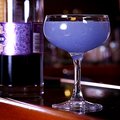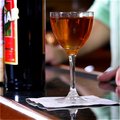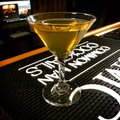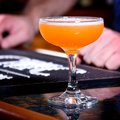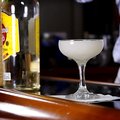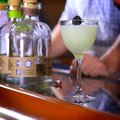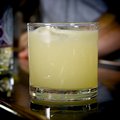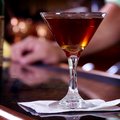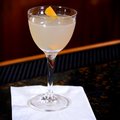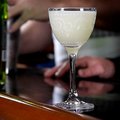Returned 14 result(s) for "Maraschino Liqueur"; page 1 of 1.
The Aviation was created by Hugo Ensslin, head bartender at the Hotel Wallick in New York, in the early twentieth century. The first published recipe for the drink appeared in Ensslin's 1916 Recipes for Mixed Drinks.
Notes:
Approachable classic cocktail with complicated herbal notes, violet/flowery mid-palate which plays well against the juniper notes. In some ways, "tastes like purple."
Filed In:
Exploring more neighborhoods of New York City, the Bensonhurst is a riff off the standard manhattan cocktail.
Notes:
A manhattan with an herbal bitter bite, similar to the bitter of a negroni.
Contains:
Filed In:
The Brooklyn is like a standard manhattan in recipe design, but created more dry by using a dry vermouth instead; Not too unlike how a dry martini and standard martini are cousins. Over the years the manhattan dominated the scene and the Brooklyn died away.
Notes:
A dry forward flavor with a subtle rye to add a mild sweetness, the maraschino liqueur is quite muted but ties the flavors together.
Filed In:
The idea of the decepticon is to deceive the drinkers eyes into thinking they're going to be sipping on a lemon drop...but they are not: this is a smoky mezcal number instead.
Notes:
A smokey citrus with undertone of maraschino liqueur
Contains:
Filed In:
This tiki drink was created by Don the Beachcomber, circa 1941. It brings passion fruit together with a rum, light on spirit but the spirits involved are fairly strong.
Notes:
Sweet and Tart with a growing tangy bite that grows on you while also bringing a good sour citrus
Contains:
Filed In:
Perhaps inspired by Pink Floyd, this came across our desk and after trying it, we realized...this is a great cocktail with Mezcal and Aperol.
Notes:
Sweet yet smoky yet bitter, a great balance of flavor experiences for mezcal drinkers.
Contains:
Filed In:
First created by Constantino Ribalaigua Vert in Cuba, this Daiquiri variation is often referred to as the Hemingway Daiquiri or Daiquiri #3
Notes:
Light sour lime against herbal maraschino sweetness and a mild yet muted rum flavor. Easy to drink, good balance.
Filed In:
Notes:
A smokey start, mild sour with a herbal finish
Filed In:
The Martinez was either the father to the Martini, a cousin to the Martini, a variation, or just a drink created around the same time period. Both the Martini and the Martinez were born between 1860 and 1870 as vermouth became more popular in the United States.
Notes:
Stong potent start mixed with orange and subtle juniper with a mid-palate and finish that lingers bitter, tart and powerful.
Filed In:
A modern twist on the traditional Paloma, created by the Luxardo company using Luxardo Bitter Bianco.
Notes:
Slight salty grapefruit and a muted sour bitterness in the tail end, tequila is quite hidden
Contains:
Filed In:
A manhattan variation based on the neighborhood in Brooklyn New York City, that brings rye whiskey together with slight variations of fortified wine, using Punt e Mes instead.
Notes:
A spicy manhattan with similar sweetness and the herbaceous maraschino flavor and muted bitterness; alcohol-forward flavor of rye.
Filed In:
Designed by the Toro Bravo restaurant in Portland Oregon. An obvious riff off the Hemingway Daiquiri or even the Dorchester cocktail with the combination of Luxardo and fresh sours!
Notes:
Earthy flavor that is light on smoke, nicely balanced mild sour against the salty mezcal bite.
Filed In:
This fantastic cocktail doesn’t have a rich deep history. We believe this was created (or at least documented) by Charles Phan’s Slanted Door.
Notes:
Floral forward herbal flavor, mid-palate citrus acidity, finishing of juniper, sweet herbaceous linger.
The Last Word has a mythical history that begins around 1916 with many folks claiming its creation or its bar menu addition, including the Detroit Athletic club and others. It was brought back to life in 2003 by Murray Stenson when he discovered it in an old cocktail book. He served it at the Zig Zag Cafe.
Notes:
A balanced herbal forward cocktail that doesn't lean towards sour, and has hints of sweetness.
Filed In:
